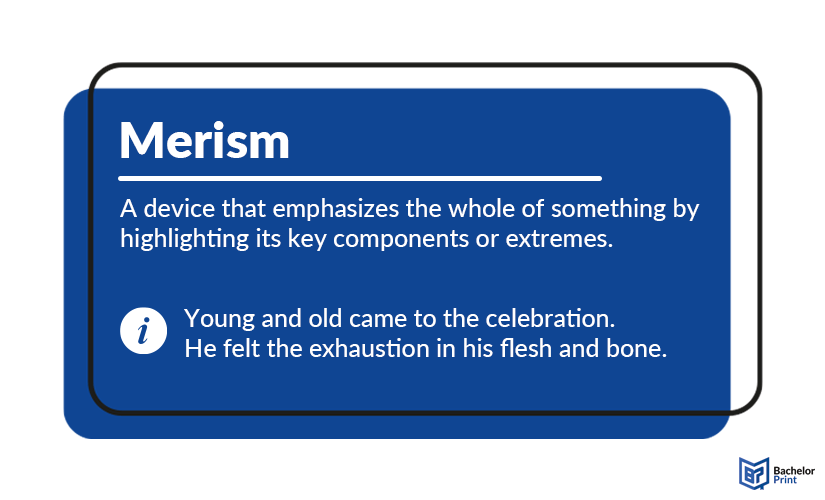
Stylistic devices can greatly improve your text and help you present yourself as a quite literate person. This applies not only to belletristic writing but also to academic writing. Even though many forms of speech find greater application in literature than in science, knowing them can be useful when you have to analyze a text. The following article will explain merism to you, showing its use and purpose, as well as examples.
Definition: Merism
A merism, pronounced mae-riz-m, is a stylistic device, where a whole is described through some or all of its parts. There is also a second option, where the entirety is emphasized through two extremes. The corresponding adjective to merism would then be meristic. It finds application in literature, especially in the Bible and everyday language, as the following examples show.

Use and purpose
Stylistic devices are always used with a specific intention. For merism, there are a few different uses authors may consider when writing. The most common one is to create a sense of completion. The list of parts forming the whole projects specific images in the reader’s mind, which instinctively connect.
The image generated is one of a fishing rod, but the message we get is that he finished everything. This is because the three words are enough to generate the image of a whole in our head, suggesting that he completed the task entirely.
Another way to use a merism is to take two extremes to describe their medium. The extremes describe to what extent something was done, similar to a hyperbole.
Good and evil are complete opposites, yet they fit together as a whole, describing the entirety of humanity on earth in this context.
numerous advantages for Canadian students:
- ✓ 3D live preview of your configuration
- ✓ Free express delivery for every order
- ✓ High-quality bindings with individual embossing

Merism vs. synecdoche
A rhetorical device, that can easily be confused with merism is synecdoche. Both use parts of a whole to replace it. However, the former one will use all (essential) parts to represent the entirety, while a synecdoche uses only one part. A synecdoche thus relies on association, while the merism focuses on images.
Examples of merism in the Bible
As merism is a very favored stylistic device in the Bible, here are a few examples found in the holy script.
FAQs
A merism is a way of describing a whole by mentioning its parts or two extremes, like “night and day” to mean “all the time.”
Famous examples of merisms are the first line from the Bible, “In the beginning, God created the heavens and the earth.” or the saying “Lock, stock, and barrel.” as well as the introduction “ladies and gentlemen.”
Merism is used to create a sense of completion but also of an extreme power. This is why merisms are often used in the Bible to express the limitless capabilities of God or the greatness of acts.
While a merism uses two extremes or all essential parts of something to describe it, a synecdoche uses only one representative part of it.
